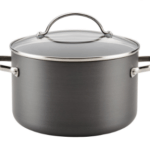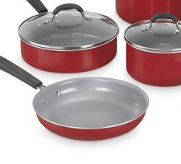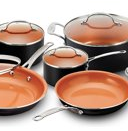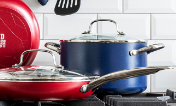For decades, Teflon coating was the ubiquitous usurper of our kitchens, but Teflon no longer has a virtual monopoly on nonstick coatings. Today, there are several healthy nonstick cookware options. I hope this post will bring you closer to deciding which one would work best for your cooking needs.
I will give you the basics of five different options, and then I’ll explore each one further in future posts.
Hard Anodized Aluminum
Hard anodized cookware is made of aluminum that has been strengthened by anodization, a process of electrolysis that creates an oxide coating on the surface of the aluminum. The oxidized layer makes it quite different from regular aluminum cookware. The surface is much harder and denser than non-anodized aluminum and nearly as strong as stainless steel. It is impact resistant, as well as corrosion and rust resistant. The surface is also non-porous and therefore non stick.
The oxidized layer makes it quite different from regular aluminum cookware. The surface is much harder and denser than non-anodized aluminum and nearly as strong as stainless steel. It is impact resistant, as well as corrosion and rust resistant. The surface is also non-porous and therefore non stick.
Good quality hard anodized pots and pans are both extremely strong and lightweight, as well as able to withstand high teperatures. Like any non-anodized aluminum cookware, they conduct heat evenly, but, unlike it, they are one hundred per cent non-reactive so will not leech into your foods, and being non stick they allow for easy clean-up.
Ceramic Coated
Ceramic non stick cookware is both PFOA and PTFE free and, if made in the USA according to FDA requirements, it is completely nontoxic. It is usually made of hard, anodized aluminum with a ceramic coating that is applied by either spraying or dipping and then “curing” in a high-heat firing process. Ceramic coated non stick cookware is easy to clean and it is supposedly heat resistant up to 842º F. Nevertheless, high heat is not recommended, as it will definitely shorten the life of the cookware.
It is usually made of hard, anodized aluminum with a ceramic coating that is applied by either spraying or dipping and then “curing” in a high-heat firing process. Ceramic coated non stick cookware is easy to clean and it is supposedly heat resistant up to 842º F. Nevertheless, high heat is not recommended, as it will definitely shorten the life of the cookware.
You’ll want to make sure your ceramic coated cookware is made by a reputable company, otherwise you will likely end up with a poor quality item that will not last long. Even high quality pans of this type are known to have a fraction of the life of a traditional non stick pan, although it is certainly a much healthier choice. Any ceramic non stick pan will be damaged by the use of metal utensil so always use wooden, silicone, or other nonstick utensils in order to preserve the non stick surface. More about healthy utensils in a future post.
Hard Enamel / Porcelain Enamel
Hard enamel or porcelain enamel pots and pans are made of metal that has been fused with an enamel coating, which creates a strong, smooth, glossy non stick cooking surface. The metal base of the cookware may be made of either cast iron, stainless steel, or aluminum. Each of these is durable, but cast iron is the heaviest and aluminum the most lightweight. Some of this cookware is also coated on the outside and comes in a rainbow of decorative colors.
The metal base of the cookware may be made of either cast iron, stainless steel, or aluminum. Each of these is durable, but cast iron is the heaviest and aluminum the most lightweight. Some of this cookware is also coated on the outside and comes in a rainbow of decorative colors.
Enameled cookware is easy to clean, can withstand high temperatures, and does not expose you or your food to any toxic chemicals. The higher the quality of the cookware, of course, the more durable, damage-resistant, and long-lasting it will be, so choose your enamel non stick cookware with care and it will serve you well for years to come.
Copper Infused
There are several manufacturers of “copper” non stick pots and pans. Some of them are copper-infused ceramic coatings and some are simply copper-colored ceramic coatings. Ceramic non stick coatings are 100% nontoxic. Copper has non stick properties and is the most efficient conductor of heat. The durability and life of the pan will depend on whether or not it is made by a reputable manufacturer and if you follow the instructions for use and care.
ceramic coatings and some are simply copper-colored ceramic coatings. Ceramic non stick coatings are 100% nontoxic. Copper has non stick properties and is the most efficient conductor of heat. The durability and life of the pan will depend on whether or not it is made by a reputable manufacturer and if you follow the instructions for use and care.
There are several companies that manufacture “copper” non stick cookware and I will explore these lines further in a future post.
Diamond Infused
This ceramic non stick coating is infused with diamonds, which is the hardest substance known to man. The diamond crystals enhance the strength and durability, as well as the non stick properties of the cooking surface. If manufacturer’s instructions are faithfully followed, this non stick coating will neither chip nor crack, and can even stand up to metal utensils (although I would still opt not to use metal).
If manufacturer’s instructions are faithfully followed, this non stick coating will neither chip nor crack, and can even stand up to metal utensils (although I would still opt not to use metal).
The diamond particals are a superlative conductor of heat, spreading the heat more quickly and evenly across the cooking surface. The higher the quality of your diamond-coated cookware and the more responsibly you care for it, the longer it will last. A reputable manufacturer and a higher price tag are pretty good indicators of higher quality cookware. All ceramic non stick cookware will eventually lose its non stick properties and need to be replaced, but even with frequent use (and proper care!) they will serve you well for several years.
If you have cooked with any of the above, I would love to hear from you! Please share your comments in the field below.
I will have further information for you about healthy non stick cookware options in my next post.
To your healthy kitchen!
Hello my friend,
I remember the Teflon days and still having to spray with Pam. My mother used to get so angry. Those were the good old days waiting for a well cooked meal. NOw I have my own kitchen and I look to cook daily.
As a matter of fact, I use the Hard Anonized Aluminum cookware which is very good for cooking soups, stews and seasoned rices. I can “bubble” my foods without fear of burning the bottom. In my opinion, the food tastes really good using this cookware. And the food keeps a warm temperature which is good for serving the family.
I have 2 sets that were gifted to me and I am not trading with them.
If I needed an upgrade where would I get one from?
Thank for this article and I wish you a Happy 2020.
Blessings always,
Maxine 🙂
Thanks so much for your comments, Maxine, and for sharing your cookware experience. Isn’t it great to know that your cookware is not compromising your healthy cooking and the health of you and your family? I’m so glad we’ve been liberated from the old days of toxic Teflon!